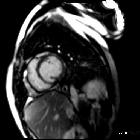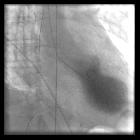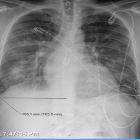inverse Tako-Tsubo-Kardiomyopathie

Reverse
takotsubo cardiomyopathy. Delayed enhancement cardiac MRI short axis showed no evidence of pathological delayed enhancement denoting no evidence of scarring.

Reverse
takotsubo cardiomyopathy. 4 chamber view delayed myocardial enhancement showing no evidence of pathological enhancement.

Reverse
takotsubo cardiomyopathy. 2 chamber view cardiac MRI with basal hyperkinesia and apical akinesia seen in classical Takotsubo syndrome.

Reverse
takotsubo cardiomyopathy: two case reports and review of the literature. Left ventriculogram of a patient with reverse-takotsubo cardiomyopathy in diastole (panel A) and systole (panel B). Arrows denote the areas of normal ventricular movement in the apical segments. The basal segments remain hypokinetic. This is in contrast to typical takotsubo syndrome, where there is “apical ballooning,” and the apical segments remain hypokinetic.

Postpartum
woman with pneumomediastinum and reverse (inverted) takotsubo cardiomyopathy: a case report. Cardiac catheterization. Hemodynamically not relevant kinking of the left anterior descending artery. Coronary arteries are otherwise unremarkable. Left ventricle angiography suggests basal to midventricular ballooning. Abbreviations: LCA, left coronary artery; RCA, right coronary artery; LV, left ventricle angiography.

Postpartum
woman with pneumomediastinum and reverse (inverted) takotsubo cardiomyopathy: a case report. Native cardiac magnetic resonance imaging cine sequences. The row above shows the end diastolic, the row below the end systolic state of the cardiac cycle. Column a shows a patient with normal left ventricular function and a symmetric contractility of the myocardium throughout the left ventricle, b shows a patient with takotsubo cardiomyopathy with normal contractility of the basal myocardium and impaired apical contractility with ballooning, c is the patient of this case report with reverse (inverted) takotsubo cardiomyopathy with normal contractility of the apical myocardium and impaired contractility of the basal parts.
inverse Tako-Tsubo-Kardiomyopathie
Siehe auch:

 Assoziationen und Differentialdiagnosen zu inverse Tako-Tsubo-Kardiomyopathie:
Assoziationen und Differentialdiagnosen zu inverse Tako-Tsubo-Kardiomyopathie:



